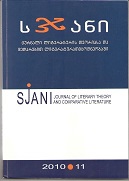ტანსაცმლის ტარების ეტიკეტი შუა საუკუნეების მწერლობაში
Dressing Etiquette in the Medieval Literature
Author(s): Maka ElbakidzeSubject(s): Literary Texts
Published by: ლიტერატურის ინსტიტუტის გამომცემლობა
Keywords: dressing etiquette; Middle Ages; Romance; “The Knight in the Panther’s Skin”
Summary/Abstract: Dressing and eating etiquettes play an important role in the culture of any civilized society. The Middle Ages can be regarded as prominent in this regard and they can conditionally be called the “ritualised era”. Clothes - “symbolic gestures in social life” (Le Goff) - occupied a most important role in the system of values. Clothes not only warmed and adorned medieval people, but they were also regarded as the main criterion defining a person’s social status. Studying the role of dressing etiquette is as important in art and literature as in social practice, as in literary works, this etiquette not only defined the social status of heroes, but it also symbolised certain turns in the plot and emphasised important passages in the narrative. In European Chivalry Romances as well as in The Knight in the Panther’s Skin, clothes have socio-cultural, socio-professional, and ritual-symbolic functions. Correspondingly: a) They help to identify a person (in this case, a hero) in society and emphasise his/ her social status and role; b) They are (together with jewellery) indispensable attributes of the main principle in feudal society - making presents; c) They symbolically reflect certain rituals and traditional rules characteristic of feudal societies; d) In a number of cases, the symbolism of clothes has not so much a purely ethnographic and ritual function, but rather an artistic and aesthetic function.
Journal: სჯანი
- Issue Year: 2014
- Issue No: 15
- Page Range: 173-182
- Page Count: 9
- Language: Georgian

